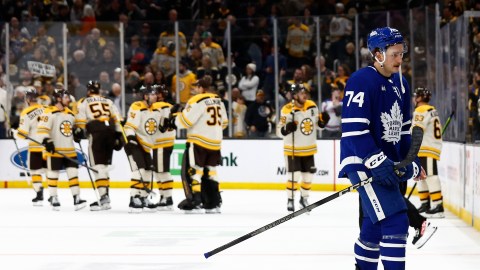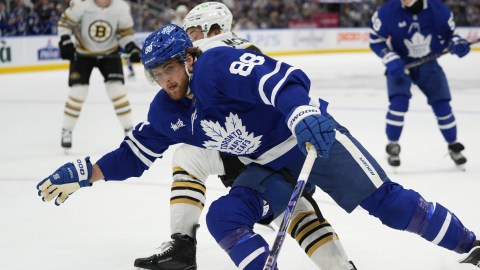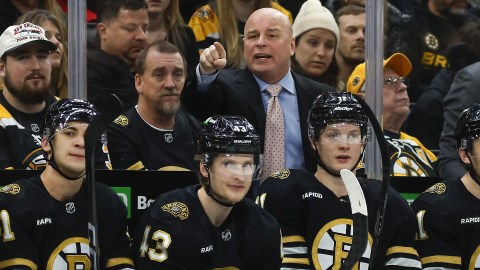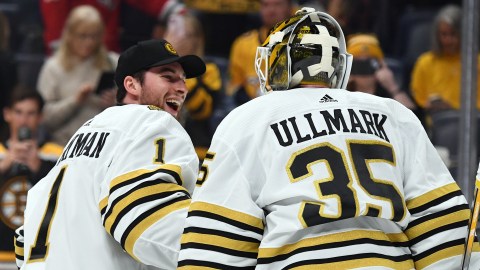The Bruins didn't open the postseason the way they had hoped with a pair of losses on home ice against Montreal. But they returned the favor with a road win off their own in Game 3 at the Bell Centre to get back into the series.
That victory gives hope to a rally to extend the season, but there's still a long way to go to get past a rival that has ended far too many Bruins seasons. While Boston prepares for a shot to pull even in Game 4, here's a look at a half dozen items from the past week that may have otherwise slipped through the cracks in this week's edition of the Bruins Shootout.
1. If there were any doubts about the importance of Zdeno Chara to the Bruins' defense, they should have been erased in the last two games of this series. Playing without their captain in Game 2 on Saturday, the Bruins' blue line appeared in disarray, with sloppy positioning and frequent turnovers. Boston's play in its own zone showed a dramatic improvement upon his return in Game 3, even with Chara at less than full strength after being hospitalized for dehydration.
Chara himself is far from immune to the occasional defensive lapse, but there's no denying he is a stabilizing force on the back end when in the lineup. Johnny Boychuk is a completely different player skating with Chara as his partner and the captain elevates the play of whoever he is paired with. He might not always dominate physically the way some expect a 6-foot-9 behemoth to do every time he steps on the ice, but even a one-game absence should give a better appreciation for all the little things that Chara does for the Bruins that often go unnoticed.
2. One stat that is usually particularly revealing at this time of year is blocked shots. When the Canadiens built their 2-0 series lead with back-to-back wins in Boston, Montreal dominated that category with 46 blocked shots to the Bruins' 21. The defense supplied 29 of those blocks, led by Brent Sopel (seven) and Hal Gill (six), but everyone got into the act with 14 different Habs collecting at least one in those two games. The Bruins turned that around in Game 3 with a 22-17 edge, led by four from Andrew Ference and three each from Chara, Boychuk and Dennis Seidenberg. Blocked shots have a tactical importance in denying scoring chances and creating opportunities to counterattack. But the significance of the stat is also that it reveals the kind of commitment a team has to winning and the sacrifices it is willing to make in that quest. Montreal had a decided edge in that area in the first two games, but the Bruins showed they were capable of the kind of effort needed to win in the postseason in Game 3, and will have to match that effort the rest of the series.
3. Tim Thomas delivered a huge win for the Bruins in Game 3 with a 34-save effort, but there was still some reason for concern. Thomas has been making plenty of stops, including some spectacular ones late in Game 3 to preserve that victory. But he's also made things harder on himself and the Bruins with some difficulty controlling his rebounds. Montreal scored two of their three goals in Game 2 on rebounds that went directly to Canadiens in prime shooting positions. The Habs couldn't convert several similar chances in Game 3, but the fact that Thomas continues to allow some juicy rebounds is a bit worrisome. The little things like that are magnified in the playoffs, and sometimes just making a save isn't enough. It's also necessary to make sure the opposition isn't in position to put the next shot in either.
4. Officiating always seems to stir up controversy in series between the Bruins and Habs, but it was refreshing to see some sensible restraint from the referees in each of the last two games. In both contests, a dirty hit by a Montreal player led to a Bruin initiating a fight to stand up for his fallen teammate. In Game 2 it was Shane Hnidy taking on James Wisniewski after Wisniewski hit Rich Peverley from behind. In Game 3, it was Ference sticking up for Boychuk after Benoit Pouliot took a run with a high hit on the Bruins defenseman.
Both Hnidy and Ference went out of their way to try to avoid jumping their opponent, but many times in the recent past officials would still hand out the dreaded instigator penalty and negate the power play (both Wisniewski and Pouliot were called for charging on their respective hits). This time though, justice was served, the offending parties were forced to answer for their misdeeds in an honorable fashion, and the Bruins still got a power-play chance of the initial offense.
That's the way it should be. But knowing how things are often called these days, the Bruins were wary of evening up the calls by seeking retribution. "I waited for [Pouliot] to drop the gloves and throw a punch before I did anything," Ference said. "I didn't want to take an extra penalty, but from what I saw it looked like a really dangerous hit. A hit like that, especially on your partner, you want to have some answer for it."
5. Getting the power play on those two occasions didn't exactly help the Bruins. Boston failed to convert either chance. In fact, they've yet to score on any of their 11 chances with the man-advantage so far in the series. They have just 13 shots on goal on those 11 chances lasting 16:59, continuing a disturbing trend from the regular season. Boston finished the year 20th in the NHL on the power at just 16.2 percent. They paid handsomely to acquire Tomas Kaberle, in large part to upgrade that unit with a legitimate power-play quarterback at the point. But the Bruins are now just 7-for-77 (9.1 percent) on the man-advantage in 27 games (including playoffs) with Kaberle in the lineup. The one bright spot is that the penalty kill has kept Montreal's potent power play almost as quiet. The Habs have converted just 1 of 12 chances in the first three games.
6. Adam McQuaid picked a bad time to have a bad hair day. Actually, the young defenseman is having a couple of bad hair weeks after getting most of the top and sides of his hair lopped off as part of the club's Cuts For a Cause charity event. McQuaid's trademark long curly mane in the back was left untouched, but the contrast with the close crop on the rest of his head is far from a flattering look.
McQuaid has done his best to hide his new do from the growing throng of cameras on hand for the ongoing playoff series by wearing hats whenever possible. "I haven't bought any new ones, but I make sure I always have one on me," McQuaid said. "Instead of getting the looks from people, I'd rather just have the hat on."
That may only be a temporary solution though, as McQuaid noted he can only do that "until it starts to get nice out and I can't wear a winter hat anymore. Hopefully by then I'll have a little on top so I can get away with it." If nothing else, the new look has given McQuaid plenty of incentive to play well enough to stay in the lineup. After all, you can't get away with wearing a hat with a suit up in the press box.



